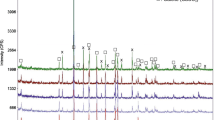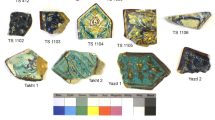Abstract
Bian-stone therapy has a long history of application in ancient China. Our recent studies reveal that Sibin bian-stone is a structurally compact micromeritic limestone with 96% (wt) CaCO3. Its normal far-infrared (FIR) radiation power is as high as 0.923 in the 8–14 μm spectral zone. In order to investigate the relation between the mineral-constituent features and IR emission ability, a detailed mineralogical study of the bian-stone sample was conducted by using the Raman spectroscopy and high-resolution transmission electron microscopy (HRTEM). The Raman spectroscopic study confirmed the existence of 1–3-μm sized pyrite, anatase and graphite in calcite interstices and revealed two broad peaks of graphite being always present in the spectra of calcite, pyrite and anatase, respectively. HRTEM studies showed that the calcite grains are composed of numerous nanometre-sized crystals, with nanometre-sized graphite commonly occurring in calcite interstices. The occurrence of nanometre-sized calcite crystals is the most important mineralogical background accounting for the good thermal radiation property of the bian-stone. The common presence of nanometre-sized graphite enhances the thermal conductivity and heat-storing capability. The good pyroelectric property of pyrite, the good infrared absorption and reflection capability as well as the high photoelectricity transformation rate of anatase subordinately enhance the infrared radiation capability of the bian-stone. It is believed that the combination of good thermal properties of the above four minerals makes the Sibin bian-stone a useful material with very good physiotherapic functions.
Access this chapter
Tax calculation will be finalised at checkout
Purchases are for personal use only
Preview
Unable to display preview. Download preview PDF.
Similar content being viewed by others
References
Qin Qiu (2002): Discovery of the Sibin bian-stone makes the rebirth of the ancient bian-stone. Journal of China Academy of Chinese Medicine (18): 4 (in Chinese).
Pan Feng and Qin Qiu (2006): Bian-stone scraping assists the development of acupuncture cause. Science News, January 16, A3 (in Chinese).
Geng Naiguang (2006): New Bian-Stone Therapy (Revised Edition). Xueyuan Press, Beijing: 13–33 (in Chinese).
Humphries, DW (1992): The preparation of thin sections of rocks, minerals and ceramics. Royal Microscopical Society, Oxford Science Publications. Microscopy Handbooks (24): 83.
Renishaw Limited. Library of minerals and inorganic materials and polymer (Database). R02-S/N H13621, INORGAN. 2002, Spectra numbers: LIB 306, LIB 83, LIB 395 and LIB 279.
Xu Peicang, Li Rubi, Wang Yongqiang, Wang Zhihai, and Li Yueqin (1996): Raman Spectroscopy in Geosciences. Shaanxi Science & Technology Press, Xi’an: 76 (in Chinese).
Pasteris, JD, and Wopenka, B (1991): Raman spectra of graphite as indicators of degree of metamorphism. The Canadian Mineralogist (29/1): 1–9.
Toulukian, YS, Judd, WR, and Roy, RF (1990): Physical Properties of Rocks and Minerals. Oil Industry Press, Beijing: pp. 299 (Translated version in Chinese).
Yu Bing and Tu Nianxi (1993): Handbook of Nonmetallic Materials. China Goods and Materials Press, Beijing: 636–652 (in Chinese).
Editorial Board of Handbook for Nonmetallic Ore Industry (1992): Handbook for Nonmetallic Ore Industry. Metallurgy Industry Press, Beijing: 84–89, 729 (in Chinese).
Ma Hongwen (2002): Industrial Rocks and Minerals. Geology Publishing House, Beijing: 479 (in Chinese).
Zhang Lide and Mou Xiumei (2001): Nanomaterials and Nanostructures. Science Press, Beijing: 525 (in Chinese).
Author information
Authors and Affiliations
Corresponding author
Editor information
Editors and Affiliations
Rights and permissions
Copyright information
© 2012 Springer-Verlag Berlin Heidelberg
About this paper
Cite this paper
Xie, X., Wang, F., Sun, Z., Lo, P.L., Kong, K.C., Xie, N. (2012). Petrological and Mineralogical Studies of the Sibin Bian-Stone, a Material for Making Acupuncture Tools in Ancient China. In: Broekmans, M. (eds) Proceedings of the 10th International Congress for Applied Mineralogy (ICAM). Springer, Berlin, Heidelberg. https://doi.org/10.1007/978-3-642-27682-8_93
Download citation
DOI: https://doi.org/10.1007/978-3-642-27682-8_93
Published:
Publisher Name: Springer, Berlin, Heidelberg
Print ISBN: 978-3-642-27681-1
Online ISBN: 978-3-642-27682-8
eBook Packages: Earth and Environmental ScienceEarth and Environmental Science (R0)




